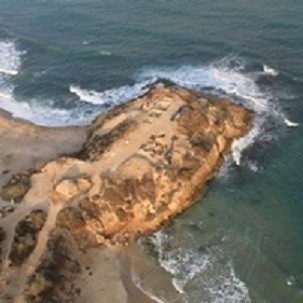Israel News: Final Stronghold for Early Islamic Power Uncovered [PHOTOS]

An ancient harbor at Yavneh-Yam was used for hostage exchange, a Tel Aviv University (TAU) researcher says.
Archaeologists have always known that Yavneh-Yam, an archaeological site between the Israeli cities of Tel Aviv and Ashdod on the Mediterranean coast, was a functioning harbor from the second millennium B.C. until the Middle Ages.
But researchers at TAU said they have uncovered evidence to suggest that the site was one of the final strongholds of Early Islamic power in the region.
Prof. Moshe Fischer of TAU's Department of Archaeology and Near Eastern Cultures and head of the Yavneh-Yam dig, says the recent discovery of a bath house from the Early Islamic period made use of Roman techniques such as heated floors and walls, which is an indication that Arabic rulers maintained control of the site up until the end of the Early Islamic period in the 12th century AD.
Researchers says when considered alongside other datable artifacts such as pottery, oil lamps and rare glass weights, this architectural feature shows that Arabic control was maintained in Yavneh-Yam at a time when 70 percent of the surrounding land was in the hands of Christian crusaders.
Fortress occupied by military
Fisher says the fortress was occupied by military officers, not by high powered rulers.
Furthermore, written Arabic sources from the same period, identifying Yavneh-Yam as a harbour, suggest that those who settled in the fortress were responsible for hostage negotiations between the Arabic powers and the Christian crusaders. The harbor itself served as a port for hostages to be transferred to their captors or returned home, according a news release from TAU.
Fischer has been excavating the Yavneh-Yam site for the past twenty years.
Among the earliest finds were two glass weights, dating from the 12th century. They bore the name of the then-ruling Arabic power, the Fatimid dynasty, indicating Arabic presence at the site, the excavators say.
But it was the discovery of a bath dating to this period and built according to Roman principles that truly gave an idea of the extent of Arabic presence in the area.
In-depth analysis
For the first time this year, researchers were able to complete an in-depth analysis of the site's promontory, the piece of land bulging into the sea that made the site a natural harbor.
The main structures consist of a series of fortification systems to include a tower and strong walls that enclose the upper part of the hill. They were found to be built in a distinct Early Islamic style.
Fisher says the Roman baths uncovered within the fortress leave little doubt that in the 12th century, the fortress was still inhabited by Arabs rather than Christian crusaders.
This is an outstanding and rare find, he says.
Fisher describes the baths as a scaled-down version of traditional Roman baths, heated by hot air circulating between double floors and pipes along the walls. The crusaders didn't build these types of baths, and after the end of the Early Islamic period, they disappear altogether.
You don't see these installations again until the revival of such techniques by modern technology during the 19th century, Fischer says. This marked the finale of the use of a traditional Roman bath house in 12th century architecture.
The fortress most likely played host to a changing roster of military captains and their men, installing the baths to provide these men with additional creature comforts. Although the baths themselves are largely destroyed now, researchers found large marble slabs that adorned the walls, and determined that the view from the baths overlooked the sea.
Researchers will continue to excavate the site, now a national park, Fischer says.
We get a nice picture of the complex relationship that existed in the Holy Land between a handful of Muslim enclaves, connected with the Arab rule in Cairo, surrounded by crusaders, he says.
© Copyright IBTimes 2024. All rights reserved.






















